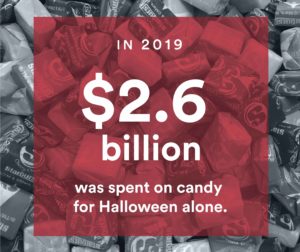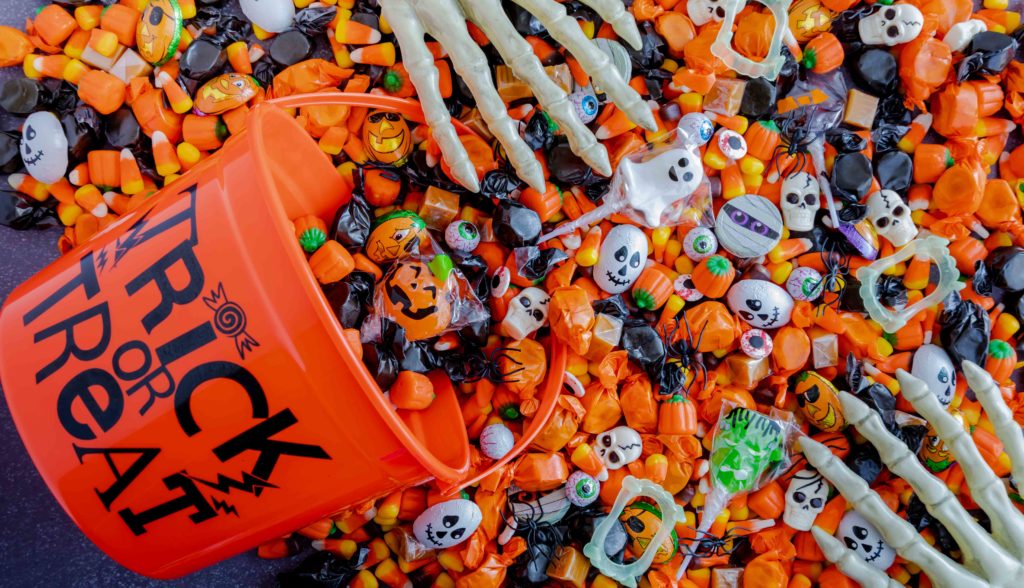Halloween is nearly here, which means it’s time to get the decorations up, carve a Jack-o’-lantern or two, and stock up on candy. However, as with most festive periods in the US, a dramatic increase in waste is expected over Halloween—waste that can and should be avoided.
This waste occurs in multiple areas, from those decorative pumpkins and festive food waste, to the plastic used for candy and Halloween costumes. The good news is there are many ways to reduce, reuse, or recycle this unnecessary waste, and focusing on those shiny wrappers or other contributors to Halloween plastic waste is a great place to start. This year try unwrapping something entirely more sustainable and learn about how to cut down on waste during the festivities.
The problem with candy wrappers
 Candy is big business at this time of year, with the National Retail Federation estimating that $2.6 billion was spent on candy for Halloween 2019. While we might see a change in 2020 due to pandemic preventions, this still represents a significant amount of candy—and a significant amount of waste.
Candy is big business at this time of year, with the National Retail Federation estimating that $2.6 billion was spent on candy for Halloween 2019. While we might see a change in 2020 due to pandemic preventions, this still represents a significant amount of candy—and a significant amount of waste.
Unfortunately, most of this waste comes from the wrapping that combines plastic and aluminum, which means it’s almost impossible to recycle. Both the metal and plastic recycling processes generally require waste to be clean and of a single type (e.g. just PET plastic). Mixed-material packaging, such as that found on candy, is not worth separating—both in terms of cost and energy. So, even if a wrapper is added to your curbside recycling, it will most likely make its way to a landfill in the end.
To make matters worse, even if the candy wrapper is made of 100% plastic, and of a single type, it is still unlikely that it will be processed due to its size and it holds no value. Candy wrappers are often simply too small to pass through the machines so it is diverted to a landfill where plastics make up almost 20% of all municipal solid waste.
What else is out there? — An alternative to Halloween candy plastic waste
Some companies are looking to find eco-friendlier versions of classic candy wrappers, and in 2016, Mars partnered with the Dutch Rodenburg Biopolymers company to create bioplastic candy wrappers. However, bioplastics create their own problems within our existing waste management systems and they haven’t yet caught on in the confectionery industry, with Mars’ attempts limited to Europe. Until this becomes a more viable option, the best path for a green Halloween is to find alternatives to those candies wrapped in plastic.

Cardboard and paper are alternatives, with the United States Environmental Protection Agency reporting that 66% of waste paper and cardboard is recycled, compared to just 8% of plastics. When stocking up and shopping for candy, look for products that come in card and paper packaging.
If you’re looking to go zero waste, then the best type of packaging is no packaging at all. For Halloween candy, this may mean thinking outside the candy box and choosing alternatives like mandarins and bananas. Buy it loose and use your own bags to purchase it from the store.
Halloween plastic waste goes further than candy
Halloween plastic waste is actually an issue that stretches far beyond candy wrappers, with costumes and decorations also creating huge amounts of waste. Research by Hubbub, a UK-based environmental charity, found that an estimated 2,000 tons of plastic waste is generated from “disposable” Halloween costumes in a single year.

Source: caddywampuslife
That’s the equivalent of 83 million plastic bottles. Researchers found that 83% of the material used in costumes from 19 supermarkets and retailers was oil-based plastic likely to end up in landfill—predominantly polyester. So, if you’re planning to buy plastic-based Halloween costumes and decorations, make sure you store them properly and pull them out again next year to upcycle into a new costume!
Having said this, you can make a significant impact on Halloween plastic waste by creating costumes out of materials you already have at home—you might even inspire others to do the same!
To learn more about how to keep plastic out of landfill and how you can reduce plastic waste, subscribe to our blog. Additionally, speak with one of our TRUE Waste Advisors to learn how to improve waste and recycling practices in your business.

